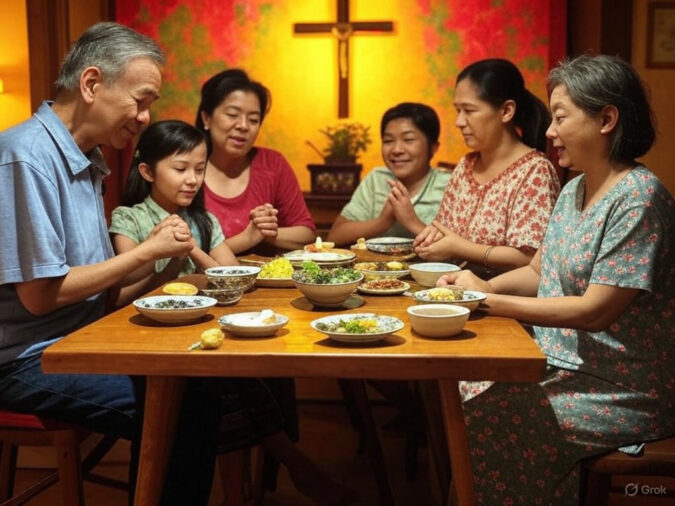
A Bisaya Prayer for Food: Giving Thanks for Daily Blessings
In Bisaya-speaking households across the Visayas and parts of Mindanao, mealtime is more than just a chance to eat—it’s an opportunity to pause, reflect, and give thanks. The act of praying before a meal, known as pag-ampo alang sa pagkaon, is a cherished tradition that reflects the deep faith and gratitude ingrained in Bisaya culture. Whether it’s a simple family dinner or a grand feast during a celebration, a Bisaya prayer for food acknowledges the divine provision that sustains life, blending spirituality with the warmth of community.
The Importance of Blessing Food in Bisaya Tradition
For the Bisaya people, food is a gift from Ginoo (God), a tangible sign of His care and abundance. Saying a prayer before eating is a way to honor this gift, expressing appreciation not just for the meal itself but for the hands that prepared it, the land that produced it, and the company that shares it. This practice is rooted in the Philippines’ Christian heritage, where grace before meals has been a staple since Spanish colonial times, adapted into the lyrical and heartfelt tones of the Bisaya language.
In daily life, the prayer might be short and spontaneous, especially for busy families. During special occasions—like fiestas, birthdays, or Christmas— it can become more elaborate, reflecting the significance of the gathering. Regardless of the setting, the prayer carries a universal message: food is sacred, and gratitude keeps the heart humble.
A Sample Bisaya Prayer for Food
Here’s an example of a Bisaya prayer for food, suitable for a family meal or small gathering:
“Ginoo, kami nagpasalamat Kanimo sa kini nga pagkaon nga Imong gihatag kanamo. Panlalangin mo kini nga pagkaon aron kini makapabaskog sa among lawas, ug tabangi kami nga dili malimot sa pagpasalamat Kanimo. Hatagi usab ug grasya ang mga wala’y makaon karong adlawa, ug tugoti nga kami mahimong paagi sa Imong kaayo. Sa ngalan ni Hesukristo, kami nag-ampo. Amen.”
Translation:
“Merciful Lord, we thank You for this food You have given us. Bless this food so it may strengthen our bodies, and help us never forget to give You thanks. Grant grace also to those who have nothing to eat today, and let us be instruments of Your goodness. In the name of Jesus Christ, we pray. Amen.”
This prayer captures the essence of Bisaya gratitude—simple, sincere, and mindful of others. It’s a reminder that even a humble meal of rice and fish is a blessing worth celebrating.
Variations Across Settings
The prayer can shift depending on the context. For a casual meal, it might be as brief as:
“Ginoo, salamat sa pagkaon. Panlalangin mo kami. Amen.”
(“Lord, thank You for the food. Bless us. Amen.”)
For a larger event, like a wedding or fiesta with tables overflowing with lechon (roasted pig) and humba (braised pork), the prayer might include:
“Hatagi’g kalipay ang tanan nga nagtapok dinhi, ug himoa nga kini nga pagkaon simbolo sa Imong gugma kanamo.”
(“Grant joy to all gathered here, and let this food be a symbol of Your love for us.”)
This flexibility ensures the prayer fits the moment, whether it’s a quiet breakfast or a festive banquet.
A Blend of Faith and Culture
The Bisaya prayer for food isn’t just a religious act—it’s a cultural expression. The language’s soft, flowing sounds—like “salamat” (thank you) and “hatagi” (grant)—carry an emotional weight that connects the speaker to their roots. In rural areas, the prayer might also nod to the land, with phrases like “Salamat sa Imong yuta nga naghatag kanamo niini” (“Thank You for Your land that provided this”), reflecting the Bisaya people’s close ties to farming and fishing.
For families, teaching children to pray in Bisaya before eating passes down both faith and language. It’s common to hear a parent gently say, “Mag-ampo ta sa dili pa mokaon” (“Let’s pray before we eat”), ensuring the tradition endures.
Beyond the Table
The prayer often extends beyond personal gratitude to a broader compassion. Many Bisaya prayers for food include a plea for those who go hungry, a reflection of the community’s empathy and solidarity. This outward focus transforms the act of eating into a shared experience, even with those not present at the table.
Conclusion
A Bisaya prayer for food is a small but profound ritual that weaves together faith, family, and culture. It turns an everyday necessity into a moment of connection—with God, with each other, and with the heritage of the Bisaya people. Whether whispered over a bowl of tinola or proclaimed before a feast, this pag-ampo is a testament to a community that finds joy in giving thanks. In every bite blessed by these words, there’s a taste of grace, gratitude, and home.